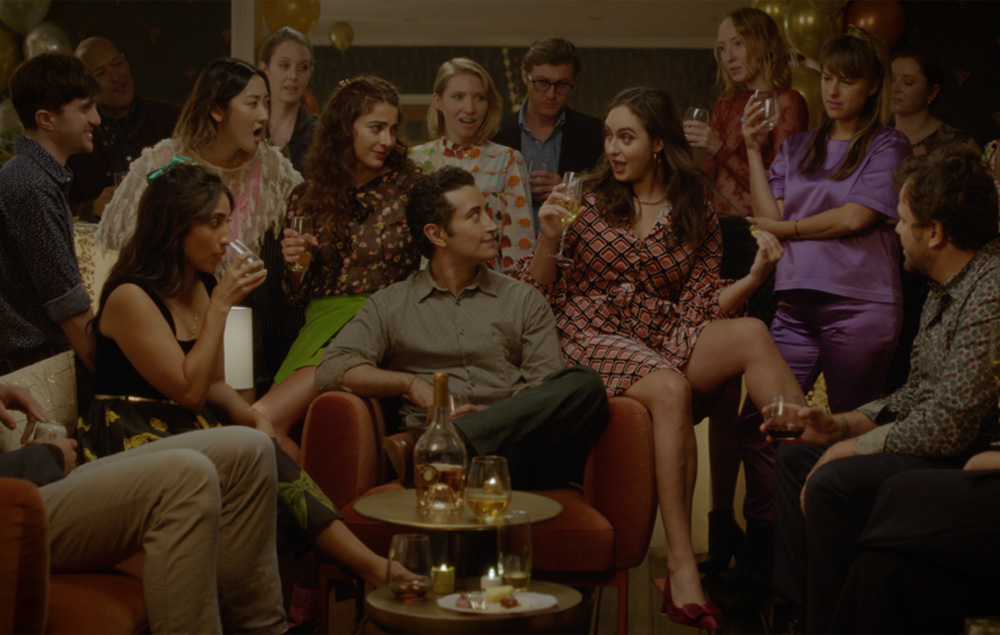“I haven’t had to write anything since college, except for e-mails,” Doug (Aristotle Athari) says, sitting in front of a blank page at his desk in “The French Italian” as he’s forced to come up with an entire script for a play with his girlfriend Valerie (Cat Cohen). He’s had no aspirations of breaking into the entertainment industry, but he’s blackmailed himself into it to some degree as he and Valerie wish to extract an apology from their downstairs neighbors Mary (Chloe Cherry) and Jordan (Jon Rudnitsky), who have struck a disturbing balance of karaoke and shouting matches to keep them up at night, and when the former is an actress, the conflict-averse Doug and Valerie believe they might be able to reflect the situation back to her to see how much pain she’s caused others by enlisting her into a paid stage production.
As crazy as this all appears in Rachel Wolther’s fiendishly clever debut feature, the idea sounds downright reasonable and fun as Valerie and Doug explain the situation to friends, all of whom ditch whatever conversations they were having at the party that opens “The French Italian” to gather around and listen to Doug and Valerie describe their two cohabitants in an Upper West Side brownstone that they are thinking of giving up, in spite of the fact that it’s rent-controlled. One theatrically-inclined pal (Ruby McCollister) suggests calling in Mary for an audition to air their grievances, but what ends up happening turns out to be a lot more for both Doug and Valerie, whose resistance to confrontation will lead them to draining their time and bank account to put on a full-fledged off-off-off Broadway show, and anyone off-screen inevitably drawn in as deeply as their friends are by Wolther’s non sequiturs and savvy staging of a comedy with an unusually rich punchline.
After previously co-directing the fantastical musical “Snowy Bing Bongs Across the North Star Combat Zone,” featuring the Cocoon Central Dance Team of Tallie Medel, Sunita Mani and Eleanore Pienta, Wolther brings a theatrical flair to her first solo feature in which misunderstandings are bound to happen when people are able to successfully curate their personal experiences and simply sidestep the parts of the world they’d rather not engage with. However, as Doug and Valerie invest all their energy into obsessing over Mary and Jordan, neglect of the issues they face in their own relationship starts to creep in, and brilliantly, the bolder and more boisterous “The French Italian” becomes, only then can it be revealed how much the two have put themselves in harm’s way by avoiding anything even moderately uncomfortable. With a soundtrack full of rococo variations on “La Bamba” and dazzling visual touches in the set and costume design, the film is easy to take in and hard to shake after with both the questions it raises and Wolther’s amusing wordplay and on the eve of its premiere at Tribeca, the writer/director kindly spoke about creating a film in which worlds collide, negotiating an indie shoot around U.N. activities at Grand Central Station, and making such great use of an eclectic ensemble.
How’d this come about?
I spent a lot of time in my apartment in New York alone in my thoughts, and I started to become one of those little old ladies who’s always looking out the window, watching what the neighbors are doing. I was taking notes [thinking] I’m going to turn this into a script, but then I was like, “Am I just a voyeur? Is my writing real stuff written down? I felt so annoyed at myself for not being like an original artist,” and then I was like, “Okay, that’s like what the movie will be about.”
For all the artifice involved, it touches on a very real idea of desperately wanting to avoid conflict – this couple refuses to tell the other what their problem is with them, to the point of staging this play, but also by obsessing about them, they seem to be avoiding any issues they have with each other. Was that something difficult to find the shape of for a film?
Yeah, I was really excited to write a movie about a couple that is constantly self-reinforcing each other. They’re always hyping each other up and agreeing in a way that you don’t even know you’ve gone totally insane until a third person enters the chat. Then you’re like, “Oh wait, I didn’t realize that we created our own reality.” So this movie is about how in New York, you live in such close proximity to all these people and you have friends that you can know for a really long time, but you only see them in certain contexts, so you have no idea what anybody’s life is really like, even people you think you’re close with.
You really figure that out visually too — what was it like creating allusions to these different worlds with the production and costume design?
It was such a team effort between me and my [director of photography] Charlotte Hornsby, and my costume designer Nell Simon and the production designer Kit [Sheridan] to be like, how can this be more colorful than real life? We’re in real locations and in real situations, but you’re in a clown car at all times. So for instance, Dawn Campbell, who did the makeup and all the hair, [would do something] just a little bit more than a real person would ever do — just like beyond. We’re making a movie about people putting on a play, and there’s a play within a play, but then the characters themselves are characters performing for each other at all times [in their regular lives] and fronting that they know what they’re doing in different social situations, so we were just trying to build those layers, using as much color and pattern and vibrancy as possible.
Did the opening come to you immediately? It not only has that story within a story quality when everyone at the party gathers around to listen to the couple’s story, but it sets the scene so well in New York where I was reminded of all these mid-90s movies that used a similar introductory device – Billy Crystal’s “Forget Paris” or Whit Stillman’s “Metropolitan” in a way.
Oh yeah, I had just rewatched “Six Degrees of Separation,” which is all told [via] Stockard Channing telling stories — every time you cut back to her, there’s more and more people listening — and I loved that so much, so I stole a little bit of that. Also because this movie is about people fronting that they know what they’re doing or they know who they are, when you tell the story of something that’s happened to you to your friends, you’ve repackaged it for them and are resituating your real life for the audience, so it’s like [this is one] audience within and there are many audiences within this film.
The casting is so perfect and when I see someone like former track star Alexi Pappas playing someone that runs in a marathon, I had to wonder whether you had some of these actors in mind while you were writing.
I didn’t really write it for anybody except Ruby McCollister, who plays Wendy. I had seen her do standup in the back of a bar eight years ago and just bomb so hard and was so committed that I’d been thinking about her ever since. The rest of the cast was really fortuitous. I think Alexi Pappas was actually kind of annoyed that I made her play a runner again because she really is like a wonderful actress and can do lots of other things. But I just thought she was so funny as someone aspirational and a fit friend.
I had a lot of mutual friends with Cat Cohen and I had seen her stand-up and was looking for someone with a really strong comedic core. She read the script in two days and liked it, and I was like, “Well, my life’s over now. Something good has happened to me.” And then I was looking for the perfect guy to play a boyfriend for her and he definitely needed comedy chops, but so many male comedians are kind of the worst person on the planet, so I was just like, “Is there anybody who seems like he would be a good boyfriend?” And Aristotle was obviously a very funny physical comedian, but I just wanted somebody warm and he really was wonderful there. I was lucky with the rest of the cast because I’ve been making movies like in different capacities in New York for a minute, so I have a deep bench of performer friends who I was able to pull in and friends of friends.
Just given the backgrounds of a lot of these actors, I had to imagine there were a lot of different approaches to the material. Was that difficult to balance out?
I was a little nervous about that, especially with Chloe Cherry, who plays the neighbor that they’re pranking. She’s done a lot of acting, but she doesn’t have like the hard comedy background that so many of the other performers did and I just threw her in and had her improv with all these actors who have been on “SNL” or are professional stand-ups and she really held her own. I was really delighted because improv is its own beast. Obviously the whole point of casting talented performers is that they do their own work. They have a process and they bring in stuff, so that’s always like a gift when you get into the editing room, especially with this movie that has a lot of group scenes and wide shots. Aristotle is doing something funny in every frame of everything we shot of him, even when he’s just behind somebody else, so that was such a gift to find.
There are a lot of performers who came in just for a day and did little parts and I tried to leave enough space on the page [where] there were characters and ideas written, but everybody could bring their own vibe. Larry Owens came in and I was like, “Can you please just like sing a little something?” And he was like, “If I must.” And then just brought it, so it was just a delight for me.
You also combine a lot of scenes – there are split-screens where the action speaks to one another, but also you’ve got those early scenes where one couple is inside their apartment and one is out. Was it tricky to connect those in advance to sync up?
That is a logistical challenge you don’t think about when you’re watching the movie because those scenes were all shot at different times and I don’t know why, but everything I’ve been writing has these separations. I think it’s because I spent so much time on the internet where I’m actually like in two places at once, so that’s how I’ve been thinking about storytelling. People are in different locations but are all tied into the same narrative. So that was hard and I’m pretty happy with how it came out.
With the split screens, I’m always thinking about “Pillow Talk” with Doris Day and Rock Hudson — the visual style and the split screens, and every outfit she wears, she has a little cape and a little hat. But those are logistically very complicated.
More so or less than filming in Grand Central Station?
Honestly, the whole MTA system is really film friendly. Let me plug New York City and how great they are for independent filmmakers. They work with your budget, they have a set schedule. We did have to rearrange because apparently the U.N. was in session, but they’re a pleasure and they gave us a four-hour permit for a really cheap price. It was interesting because Cat had a new special on Netflix while we were filming, so she kept getting recognized whenever we were out on the town, which was really fun, but also like, “Stop staring at her, I have to shoot the scene.”
I had to also bring up the music, which seems so key to the tone of the film that it seems like it had to start at a molecular level. What was it like to work on?
Ike Ufomadu, who’s in this movie, made a movie with my buddy Graham [Mason] called “Inspector Ike,” which I just love and they had this incredible soundtrack done by Simon Hanes, so I [asked them], “Can you guys hook me up with Simon?” He’s a mensch and lives in Brooklyn and has the best band in the world Tredici Bacci, and because he’s in an actual band with 10 people in it, he music process was a little bit bigger and more involved than you would normally get to do for a movie of this size, because Simon like was able to put that together for me. He wrote all the score and we worked it in while we were editing and then once it was locked, we went into a studio with a string orchestra and got to record all the real instruments while the movie was playing like they did when they made “The Phantom Menace.” I remember there was like a featurette [of the scoring sessions] that was on MTV every fucking day, and I thought, “Wow, I’ve really made it.” Then the karaoke songs were written by Showtime Goma, this great pop singer in New York who wrote some original tracks to put in.
Was that A-capella version of “La Bamba” as fun to figure out as it sounded?
Oh my God, yes, because I found out “La Bamba” is in the public domain. That’s an old folk song, so we got free reign and it’s been recorded millions of times in every different style, so there was so much inspiration and Simon went berserker with it. He came up with all the weirdest ways to rearrange this song that everybody knows. A choral one was hilarious, then the operatic one and then he did one that was just a saxophone in four parts and the sax is just like really wailing for it. I ended up like using that as transition music throughout the whole movie because it was cracking me up.
As it will for audiences as well. Even with the premiere still to come, what’s it like to get to this moment?
It’s exciting. I’m really nervous for people to see it and I can’t believe I got all these incredibly talented performers to say all these stupid things I wrote. This movie is like the Rachel Show, and it’s just been my little baby and it’s like I’m taking it out to the sea and I’m excited and nervous to see what people think.
“The French Italian” will screen at the Tribeca Festival at the Village East on June 6th at 8:30 pm, June 7th at 2:15 pm and June 14th at 8 pm and at the SVA Theatre on June 16th at 8 pm.




